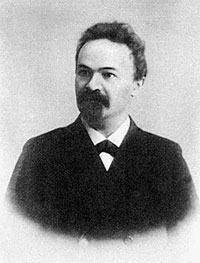Zinaida Vengerova
Zinaida Vengerova | |
|---|---|
Sveaborg, Finland | |
| Died | 1941 (aged 73–74) New York City, U.S. |
| Occupation | Literary critic, author |
| Education | Institute of Higher Studies for Women, St. Petersburg (European Literature) Sorbonne |
| Literary movement | Symbolism, Decadent movement |
| Years active | 1908–1941 |
| Spouse |
Nikolai Minsky (m. 1925) |
Zinaida Vengerova (April 19, 1867 – 1941) was a Russian literary critic and translator. She is considered one of the few women who were highly educated during her time, having studied in universities in Russia, France, and England.[1] For her works, she had been described as "a literary ambassador between East and West".[2] She also influenced the first generation of Russian symbolists through her writings about French symbolism.[3]
Biography
Vengerova was born on April 19, 1867, in
Vengerova grew up in Saint Petersburg before her family moved to Minsk, where she completed her gymnasium education in 1881.[4] At an early age, Vengerova was exposed to literature and foreign languages. She continued her education in Vienna, where she studied in western European literature and went back to St. Petersburg to study at the Institute of Higher Studies for Women from 1884 to 1887.[4]

Vengerova relocated to Paris, where she took classes in literature at the Sorbonne.[7] She became acquainted with and was a long-time friend of Olga Petit, the first French woman to become a lawyer.[7] In 1925, Vengerova married the symbolist poet Nikolai Minsky.[8]
Vengerova was an émigré in Berlin, then Paris, and London. She went to live with her sister Isabelle Vengerova - a noted pianist[5] - in New York after her husband's death in 1937 and lived there for four years.[8][2] She died in 1941.[4]
Works
Vengerova moved to London to work for the British Museum.[4] From 1908 to 1912, she built her reputation in England serving as a specialist in Russian literature.[2] By 1917, her translation of B.V. Savinkov's The Pale Horse was published in London and Dublin.[2]
Vengerova is known for her criticism of conservatism as demonstrated in her approach to Russian literary criticism amid the new literary movements.[7] She also stressed individuality and criticized portrayals of divisions between men and women based on biology.[9]
Aside from her translation works, she wrote essays on noted literary figures such as Henrik Ibsen, Paul Verlaine, Arthur Rimbaud, H. G. Wells, Ezra Pound, Arthur Schnitzler[10] and Gerhart Hauptmann, among others.[1] She also wrote a column covering European literature for Vestnik Evropy (The Herald of Europe) periodical for fifteen years.[1]
Decadence and symbolism
Vengerova and her husband became active in the Russian
In 1905, she became the center of a minor controversy involving its adherents. Her husband instigated a protoecumenical ritual participated in by a group of intellectuals. It included drinking the "donated" blood of Vengerova.[13] The event, which was intended as a bonding ritual, was described in the media as esoteric and anti-Semitic.[13] Vengerova and her husband were both Jewish.[13]
Publications
- Symbolist Poets in France (Poety-simvolisty vo Frantsii) (1892)
- Literary Characteristics (1897-1910)[1]
- English Writers of the 19th Century (1913)[1]
- English Futurists (Angliiskie Futuristy) (1915)[14]
- Sobranīe sochinenīĭ
References
- ^ a b c d e "Vengerova, Zinaida (1867–1941) | Encyclopedia.com". www.encyclopedia.com. Retrieved January 20, 2021.
- ^ ISBN 978-90-04-16844-2.
- ISBN 978-0-19-880212-9.
- ^ ISBN 0-8153-1797-2.
- ^ ISBN 0-271-00313-8.
- ISBN 978-0-295-80083-7.
- ^ ISBN 978-3-631-53295-9.
- ^ ISBN 978-1-58046-395-9.
- ISBN 978-0-89357-354-6.
- ^ The correspondence was edited in German: Die Korrespondenz von Arthur Schnitzler mit Isabella und Zinaida Vengerova. Ed. Konstantin Asadovski und Martin Anton Müller. In: Hofmannsthal-Jahrbuch zur europäischen Moderne, 2022, pp. 7–94, https://doi.org/10.5771/9783968219257-7
- ISBN 978-1-4438-2392-0.
- ^ ISBN 978-0-299-32040-9.
- ^ ISBN 978-0-299-21833-1.
- JSTOR 24726191.
